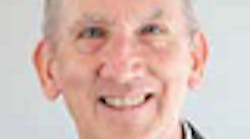Elephants are awesome; but even washed before a parade, as the beasts lumber by, it’s not a desirable odor for those in the audience front row.
The particular elephant is not responsible. It is an elephant because its DNA is elephant DNA, which has evolved to be best suited for the ancient elephant environment. Whether you want to think the present elephant is the result of natural selection from random DNA perturbations, or creative DNA design by an intelligence beyond us, is irrelevant. Today’s elephant is right for the elephant’s environment. Its attributes (size, speed, lifespan, drivers to care for babies, the food it eats, how it acquires food, how it digests food, defense against predators, etc.) all combine to create an animal that is successful in the tropical environment.
The particular elephant cannot be blamed for choosing a body that I find malodorous. Its ancestry did not consider me when it was becoming today’s elephant, an entity best suited to its ancestors’ environment.
If we discover that the undesirable odor is the result of their diet and digestion processes, and decide to feed all elephants fish, or to change the biotic balance in their digestion, they may not survive. If we decided to move all the elephants to a colder environment, they may not survive. If we change the natural environment from the complex aspects for which they were designed to be successful, they may not survive.
This, of course, is not about elephants. It is about the academic-practice gap.
There is a common complaint from the practice community that college courses in process control don’t teach the right topics. It’s often called the gap. Industry has often tried to relay to academe the body of knowledge that is important for process control, but something makes engineering instructors ignore that. They still shape the course to be about differential equations and Laplace transforms. Like elephants in their habitat, players within the academic environment have evolved practices and procedures to best survive in the academic environment. If we gave an elephant a choice to eat plants or fish, it will choose to eat the plants. If we give the professor a choice of what to teach, they choose topics for their well-being.
Instructors choose the books for the course, and a successful author is one who writes a text that will be chosen. Authors know that closed-form mathematical analysis provides academic stature, and it’s a familiar and useful skill to the instructor. By contrast, practice-relevant methods for choosing cascade, expedient and online tuning of controllers, selecting filtering, designing a cross-limiting structure, specifying where to locate a valve and which valve Cv and characteristic to choose, selecting sensor type and location, adjusting pump capacity to be compatible with the instrument system, calculating SIL and such, are substantially grounded in heuristics and judgement about the context.
Although this knowledge is essential to become a process control technologist, this means that any of many student answers to an exercise could be right, or that a student’s solution approach could have partially undesirable aspects. A grader must have significance practice experience to relay to the student the nuances that led to point deductions. This makes grading difficult. By contrast, if the professor assigns a mathematical derivation with one right answer, and every other answer wrong because of concept or derivation errors, then it is simple, convenient and safe to grade. And! The grading can then be off-loaded to a teaching assistant. The student can’t argue that the Laplace transform of an integral could be . But, the student could argue that cross-limiting control was not the right answer, because the professor did not adequately describe the impact of one variable not following-up and not leading-down another variable relative to the complexity and cost issues of a cross-limiting solution. It is difficult to completely include context in test questions. And, context is important.
Further, most faculty members aren’t hired because they have practice expertise. They are hired because of their potential to bring in science-based funding to support the graduate research program, and their potential generation of publications leading to perceived intellectual leadership among the world academic community. It would be rare for an academic program to have a control practice expert teaching the course. More likely, the instructor will have had the one academic process control course, years prior, and think that it’s about mathematics. And, if they happen to look at a practice-oriented book, they will recognize that other style that, for them, leads to unsafe assessment of student learning. They will choose a book that appeals to their interest, embodies their knowledge, has academic stature and affirmation, and permits TAs to do the grading on defensible black-or-white answers. Already working 60 hours a week for tenure, striving to find research funding to fill in the salary void of summer funding, and trying to meet family obligations, you can’t blame a professor for making, and rationalizing, expedient choices for a managing a course.
It’s not the professor’s fault. It’s not the program’s fault. Their ancestry evolved today’s academic process based on survival of the program and professor within the academic environment. Even if the professor wishes to provide a career-relevant course, the experiment will lead to the instructor’s un-wellness, and return the course to mathematical science.
I think that differential equations and Laplace notation should be included in the process control course. But, those topics should be taught as needed to provide the grounding for the important topics, not as the key content of the course. It’s not that the current courses teach wrong things, it’s just that the environment shapes professors who place too much focus on things of minor need in practice.
Contrasting industrial attempts to guide process control courses, there are also academic surveys of instructors about what they choose for course content, to identify a consensus of best practices. If the elephant was told elements of the best diet for a bird, would the elephant eat it? Or would the elephant follow best practices of the elephant community?
If we want to change what is taught in the classroom, then we need to change the environment in which current practices have evolved. But, then the instructional practices and faculty persona that have evolved academically would not be suitable. If we change the academic environment, the faculty members will have to evolve.
Fortunately, humans can adapt their behavior to changes in their political-economic system. Changing behavior is different from changing the machine. Primitive villagers learn better ways to manage life with training from Peace Corps and similar organizations. People can survive after a political revolution in their country. Children can address their parents on a first-name basis in the presence of customers, when they grow up and become a partner in the family business. And, professors can teach the design courses, where the student’s subjective choices need to be defended. Many programs hire instructors with the title clinical, adjunct, or professor of practice to provide the practice-relevant expertise. Although this is often very difficult to defend within the academic environment, it can happen.
Don’t blame the gap on the instructor or the program. Humans designed the game rules of the university environment, and that environment is the reason we have a gap. The situation is not exclusive to engineering. It is common professionally and worldwide. Search the Internet for “seeking to bridge the academic-practice gap,” I found much about the gap, but no organizations seeking to bridge it.
What can you do? Bridge your personal theory-to-practice gap with information in periodicals, product bulletins, industry sponsored training courses, and books written by practitioners. Don’t study more academic theory. But also, don’t reject the fundamentals from your college courses. They are a right set of topics that enable you to understand the rational for best practices. Build your bridge, the one you need to connect the fundamentals to the practice.
In school, you were told to learn what the teachers provided. But now, you must look elsewhere to develop your potential.






